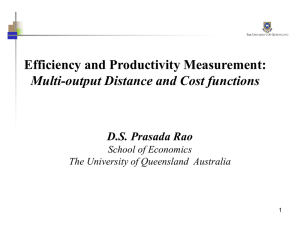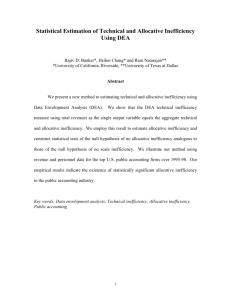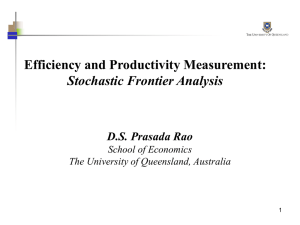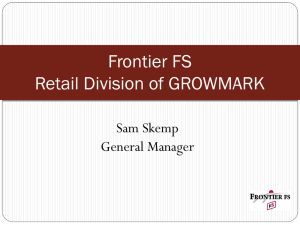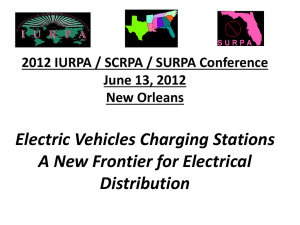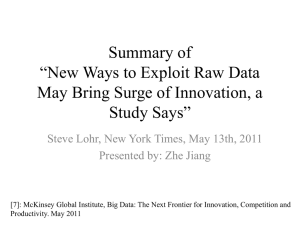This study estimates the levels of productivity, efficiency and
advertisement
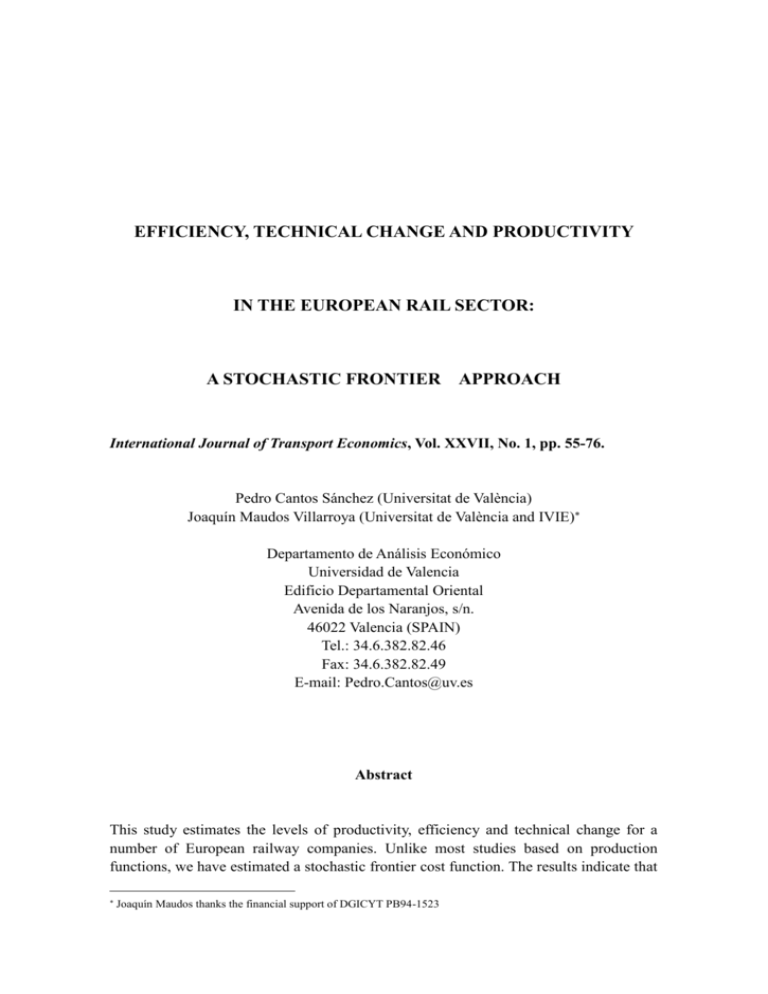
EFFICIENCY, TECHNICAL CHANGE AND PRODUCTIVITY IN THE EUROPEAN RAIL SECTOR: A STOCHASTIC FRONTIER APPROACH International Journal of Transport Economics, Vol. XXVII, No. 1, pp. 55-76. Pedro Cantos Sánchez (Universitat de València) Joaquín Maudos Villarroya (Universitat de València and IVIE) Departamento de Análisis Económico Universidad de Valencia Edificio Departamental Oriental Avenida de los Naranjos, s/n. 46022 Valencia (SPAIN) Tel.: 34.6.382.82.46 Fax: 34.6.382.82.49 E-mail: Pedro.Cantos@uv.es Abstract This study estimates the levels of productivity, efficiency and technical change for a number of European railway companies. Unlike most studies based on production functions, we have estimated a stochastic frontier cost function. The results indicate that Joaquín Maudos thanks the financial support of DGICYT PB94-1523 the principal source of productivity growth is technical progress, followed by gains in efficiency (catching-up). It can also be seen that the most efficient companies are those with a greater degree of financial and management independence. 2 1. Introduction In recent years the international railway sector has been involved in a thoroughgoing process of transformation as a consequence of two phenomena: the de-regulation of the sector and the intense competition from other modes of transport. This last phenomenon has caused the market share of the railways to be drastically reduced, in favour of other, more competitive, modes of transport such as road transport and even air transport. Criticisms were also levelled at the management of most railway companies, habitually publicly owned monopoly enterprises, which in many cases acted as mere government departments. Thus the companies were said to act with a high level of inefficiency, because of their non-commercial character, and their limited concern for the efficient management of their resources. One of the basic objectives of the current liberalisation measures is to deal with this problem by installing the incentives necessary for the companies to improve their levels of efficiency and productivity. In this line, research carried out to analyse the evolution of the productivity and efficiency of the sector in recent years constitute a first assessment of the measures taken in the sector. Thus, although the most important measures were taken very recently1, in the 1980s most of the European companies restructured their internal organisation in order to give them greater autonomy, which would allow them to 1 See Kopicki and Thompson (1995) for a description of the most important deregulation and privatisation measures carried out in the sector (United Kingdom and Sweden, or Argentina, Japan and New Zealand for other non-European liberalization experiences). 3 improve the management of the companies and thus their productivity. In transport economics relatively few studies have been concerned with assessing the evolution of the productivity levels of the sector. The estimation of economies of scale has been the basic aim of most of these studies2, since the existence of such economies has been one of the basic arguments justifying the maintenance of regulation in the sector. The first studies by Caves, Christensen and Swanson (1980 and 1981) applied a simple method to determine the changes in the productivity of North American railway companies on the basis of a cost function. Later Bereskin (1996) broadened the sample period analysed, showing that the de-regulation measures carried out since the application of the Staggers Act in 1980 have achieved clear improvements in the productivity levels of the sector. A common aspect of many of the studies that analyse total factor productivity in railway companies is the use either of accounting approaches or of index numbers 3 which, as Grosskopf (1993) shows, offer biassed results for productivity in the presence of inefficiency, or estimations of average production or cost functions rather than genuine frontiers. For these reasons, studies like those by Perelman and Pestieau (1988) and Compagnie, Gathon and Pestieau (1991) analysed the efficiency of companies with 2 For the case of North American companies, see the studies by Caves et al. (1981), Caves et al. (1985), Kim (1987), Berndt et al. (1993), Friedlander et al. (1993); and for European companies, those by Filippini and Maggi (1992), De Borger (1992), McGeehan (1993), and Preston and Nash (1996). 4 respect to their different operating environments by means of frontier approaches that explicitly incorporate efficiency into the analysis as a source of productivity growth distinct from technical progress. Oum and Yu (1994) estimate the levels of efficiency for a sample of companies applying the methodology of data envelopment analysis (DEA). This approach has certain advantages over parametric approaches: it is not necessary to specify a functional form, or to introduce any kind of assumption as to the distribution of inefficiency. The above-mentioned studies that use frontier approaches have used a determinist approach, which assumes that any deviation from a firm’s frontier is explained exclusively by its inefficient behaviour. This may cause estimations of inefficiency to be upwardly biassed by capturing as inefficiency the effect of variables that are beyond the control of the company (errors of measurement, bad luck, etc.). Subsequently, Gathon and Pestieau (1995) estimated a stochastic frontier production function, on the basis of which, as well as estimating the variations in the productivity of the sector, they break them down into changes in the levels of efficiency of the companies (catching-up) and of technical progress. The estimation of technical progress is achieved by introducing a time trend, which interacts with the input variables considered in the model. The problem with frontier production functions is the need to 3 See, for example, Tretheway et al. (1997). 5 aggregate in a single measurement the different outputs offered by the railway companies, thus losing the possibility of capturing the advantages of specialisation in the productive behaviour of the companies. Gong and Sickles (1992) used a study by Monte Carlo to compare the results obtained with DEA and stochastic frontier techniques in the measurement of efficiency levels of a sample of companies. Their results indicate that on many occasions the stochastic frontier approach represents individual efficiency and productivity levels better than DEA approach. For this reason, the approach chosen in this study is that of the stochastic frontier. It is intended thus to solve one of the problems of determinist frontiers mentioned earlier, namely that estimations of inefficiency may be upwardly biased. We will also estimate a cost function instead of a production function. In a highly regulated context such as that of the railways, it is to be expected that companies will attempt to minimise the costs of a certain level of production. For this reason it is of greater interest to analyse cost inefficiency (including both the technical and allocative types) than the technical inefficiency analysed by the studies that estimate production functions. Furthermore, the estimation of a cost function presents the added attraction of enabling the multi-product nature of the production to be taken into account through the specification of different outputs. 6 Our study aims, first, to assess the inefficiency levels of the principal European companies and to specify their main determinants or explanatory factors. These determinants include factors such as the degree of autonomy and financial independence, numbers of passengers and tons carried per train, the traffic density indices or the degree of electrification. Also we will evaluate the rate of technical progress on the basis of the introduction of a trend, in a similar way to Gathon and Pestieau (1995). Another advantage of this type of specification is that it enables us to estimate economies of scale and consequently to evaluate the inefficiencies produced by the wrong scale of production at which the companies operate. Thus this approach allows us to calculate the growth rate of total factor productivity distinguishing between the movements of the cost function due to technical progress, changes in efficiency of companies, and movements along the cost function due to the economies of scale. Finally, one element that justifies the diversity of the results obtained by the literature is the different specification of the variables representing output. Two types of variables are normally used in these models. First, the variables passenger-Kms and Ton-Kms are the series most used in the literature. The greatest disadvantage of these measurements is that they can be strongly influenced by the regulatory system operating in each country. For this reason, measurements of output such as passenger and freight train-Km are more appropriate when attempting to assess the behaviour of companies in heavily 7 regulated environments. We have therefore opted for this latter modelisation of output. The study is organised as follows. Section 2 describes the stochastic approach to the analysis of efficiency. Section 3 describes the sample, and the variables used in our model. Section 4 shows the indices of efficiency and their determinants for the various companies. Section 5 analyses inefficiencies of scale, technical progress, and the growth of total factor productivity. Finally, in Section 6 we will present the main conclusions of the study. 2.- The stochastic frontier approach Since the pioneering study by Farrell (1957), the measurement of inefficiency has run parallel to the estimation of frontier functions. Inefficiency being defined as the difference between the observed level of the variable being studied (production, costs, profits, etc) and the maximum attainable, situated at the frontier, the measurement of inefficiency necessarily requires the estimation of the frontier function. The so-called X-inefficiencies are inefficiencies due to errors of management and/or organisation. They include inefficiencies both of the technical type (the current level of production could be produced with a smaller amount of input) and of the allocative type (the proportion of inputs used is not the one that minimises costs given their relative 8 prices), and differ from inefficiencies of scale in that the latter arise from the choice of a scale of production at which average costs are not minimised. This definition **is equivalent to the original definition of X-inefficiency which captures the technological and management differences that increase production costs4. The stochastic frontier approach was introduced simultaneously by Aigner et al. (1977) and Meeusen et al. (1977). This approach modifies the standard production (or cost) function by assuming that inefficiency forms part of the error term. This composite error term therefore includes an inefficiency component and a purely random component that captures the effect of variables that are beyond the control of the production unit being analysed (weather, bad luck, etc). Thus, the principal attraction of the stochastic frontier approach as against determinist approaches such as DEA is that it isolates the influence of factors other than inefficient behaviour, thus correcting the possible upward bias of inefficiency of the determinist methods. Furthermore, unlike DEA, the estimation of efficiency is less sensitive to the existence of outlayers in the sample5. The basic stochastic cost frontier model posits that the observed costs of a firm deviate from the cost frontier as a consequence of random fluctuations (vi) and of inefficiency 4 The original study by Liebenstein (1966) distinguishes between X-inefficiencies and allocative inefficiencies (the social costs driving from the power of the market and from restrictions on trade that cause a bad allocation of resources among firms, industries and nations). This last idea of allocative inefficiency differs from the commonly used concept of allocative inefficiency as the increase in costs deriving from the choice of an incorrect proportion of inputs given their relative prices. However, both technical and allocative inefficiency are frequently lumped together in the generic concept of X-inefficiency. For this reason, throughout this study the term X-inefficiency will refer to the total inefficiency, the more so as when estimating a cost function the cost inefficiency includes both the technical and the allocative type. 5 A review of the different techniques for measuring efficiency can be found in Bauer (1990), Green (1993) and Lovell (1993). 9 (ui). Thus, in the case of the cost frontier: LnCi LnC (Yi , Pi , ) i i u i vi i 1, ..., N (1) where Ci are the observed costs of company i, Yi is the vector of outputs, Pi is the vector of input prices, is the vector of parameters to be estimated, and LnCi(Yi,Pi,) is the logarithm of the predicted costs of a company that minimises production costs. The random error term vi is assumed to be independent and identically distributed, and the inefficiency term ui is assumed to be distributed independently of vi. In order to separate the two components, it is necessary to make distributional assumptions regarding both components of the composite error term. Since the inefficiencies can only increase costs above the frontier, it is necessary to specify asymmetric distributions for the inefficiency term. It is usually assumed that vi is distributed as a normal with zero mean and variance 2v, and ui as a half-normal (ui is the absolute value of a variable that is distributed as a normal with mean zero and variance 2u) Under the assumption that both components of the error term are distributed independently, the frontier function can be estimated by maximum likelihood, inefficiency being estimated from the residuals of the regression. More specifically, the individual estimations of inefficiency can be obtained by using the distribution of the 10 inefficiency term conditional on the estimate of the composed error term. Thus, Jondrow et al. (1982) show that in the case of the half-normal distribution, the mean of this conditional distribution adopts the following expression: EF exp Eu i (u i vi ) E u i (u i vi ) ( i / ) i (1 2 ) ( i / ) (2) where =u/v, 2=2u+2v, and and are respectively the density and distribution functions of a random variable that is distributed as a normal. EF is the efficiency of each company defined as the ratio between the minimum costs situated at the frontier and the costs really incurred. In order to analyse the economies of scale, the X-inefficiency and the technical progress of the European railway sector, we will estimate a translogarithmic frontier cost function because of its greater flexibility in relation to other specifications. Essentially, the translog function is a quadratic approximation obtained as a Taylor approximation around the point of approximation. Among its main advantages are the following: 1) it does not impose any a priori restriction on the elasticity of substitution among inputs; 2) it allows the estimation of the cost function to have the form of U; and 3) it allows potential cost complementarities through its multi-product specification. In the particular case of a cost function with two outputs and three inputs, the translog function adopts the following specification6: 6 We impose the habitual restrictions of symmetry and linear homogeneity in the prices of the productive factors. 11 2 LnTC it 0 j LnY jit j 1 3 l LnPlit l 1 1 2 2 jk LnY jit Ln Ykit 2 j 1 k 1 3 3 2 3 1 LnP LnP jl LnY jit LnPlit lm lit mit 2 l 1 m 1 j 1 l 1 (3) 2 3 1 T T TT T 2 Tj T LnY jit lT T LnPlit u it vit 2 j 1 l 1 where i refers to the company, t to the year, TCit= total costs, Yit is the vector of outputs, Pit = is the vector of inputs, T=1,2,..,T, uit the inefficiency and vit the random disturbance term. Note that a trend T has been introduced in order to reflect the influence of technical progress. The more flexible alternative of introducing time effects to interact with the other regressors presents the problem that it increases considerably the number of parameters to be estimated, thus generating a high multicolinearity. 3. The data The sample used covers the years 1970-1990. It was impossible to extend the period to more recent years, as in 1991 the accounting systems of the companies changed considerably. The data were obtained from the reports published by the UIC (Union Internationale des Chemins de Fer). The total number of companies included in the model was 15 (see table 1), although for some of the companies complete information was not available for all years. 12 During the period of estimation no significant reforms occurred in the majority of the companies. Only the Swedish company SJ carried out an effective process of separation of infrastructure and services in 1988. In the late 1980s many companies undertook processes of restructuring whereby it was intended to give them greater management autonomy, by promoting the separation of the various railway services into differentiated lines of business. Operating costs, including labour costs, fuel and energy, and the consumption of materials and purchases and external services, were taken as the dependent variable. The introduction of physical capital costs causes substantial problems of homogeneity in the sample, so they were not included. As the variable representing the index of labour prices, we took the labour costs divided by the total number of workers in the company (P1). To represent the price of fuel, the costs deriving from energy and fuel were divided by the total train-Kms supplied by each company (P2). Finally, the variable representing the price of materials and external services was taken as the cost deriving from materials, supplies and external purchases divided by the total train-Kms of each company (P3). This approximation for the prices of inputs is similar to that proposed by Preston (1994) and Preston and Nash (1996), given the impossibility of obtaining any more rigorous indices. All these variables were expressed in constant dollars of 1990, by means of the 13 Purchasing Power Parity (PPP) indices obtained from information available in the reports of the OECD. It is habitual in estimations of the cost functions of transport companies to introduce variables that represent the size of the network. However the introduction of this into our study caused obvious econometric problems, given the high degree of correlation between the variable representing the network (length of route) and the output variables7. Since our study only proposed to analyse and break down the growth of total factor productivity (TFP) without considering the optimum level of the network, we opted not to include this variable. In this way we assume that the companies’ costs change independently of the size of the companies’ network. We therefore estimate economies of scale allowing variation in the size of network of each company. As variables representing the different outputs of the railway companies we have used the number of passenger train-Km (Y1) and freight train-Km (Y2). The reasons for choosing this specification have already been given, and respond to the need to evaluate the management of railway companies in closely regulated environments. During the estimation period there were no significant reforms in the sector, except for that carried out by the Swedish company SJ in 1989, consisting of the effective separation of infrastructure from services8. 7 Oum and Waters (1998) point out the econometric problems that may be caused by the introduction of network variables if they are not properly treated. 8 As is well known, some countries have recently begun important restructuring processes in this sector. The British case stands out, in which as well as in 1995 separating the management of infrastructure and of services, a process of privatisation of the whole sector was begun, which has now practically finished. 14 Table 1 gives a summary of the principal statistics of the variables for the sample as a whole. 15 Table 1. Principal statistics of the sample (Averages for the period analysed). Y1 (in thous.) Y2 (in thous.) P1 P2 BR* United Kingd. 340582,2 81192,1 15,85 0,71 CFF Sweden 71572,2 28264,5 22,22 0,52 CH Greece 13606,7 3236,0 11,51 0,88 CP Portugal 27077,7 6510,3 9,99 1,38 DB Germany 393556,3 199395,7 23,71 0,96 ** DSB Denmark 39475,3 8134,3 14,76 0,82 FS Italy 223832,3 59463,8 18,41 0,38 NS Holland 96667,6 13788,8 19,30 0,59 NSB Norwege 22671,8 10495,3 13,63 0,54 ÖBB Austria 60679,4 35715,3 14,63 0,63 RENFE Spain 96569,3 44859,9 16,84 1,02 *** SJ Sweden 59984,1 40451,9 15,13 0,48 SNCB Belgium 68090,7 22291,4 22,25 0,90 SNCF France 284255,9 198204,2 18,19 0,53 *** VR Finland 23575,0 18405,3 10,92 0,69 * Except years 1970,1971 and 1972 ** Except years 1973,1974, 1975 and 1976 *** Except the year 1990 Table 2. Efficiency levels (EF) MED MIN BR 0,9127 0,8168 CFF 0,9243 0,8736 CH 0,8030 0,5853 CP 0,8471 0,6684 DB 0,8900 0,8311 DSB 0,9120 0,7496 FS 0,7507 0,4460 NS 0,9315 0,8897 NSB 0,8722 0,7290 OBB 0,8085 0,6451 RENFE 0,9057 0,8514 SJ 0,9394 0,8470 SNCB 0,7625 0,6408 SNCF 0,8850 0,7882 VR 0,8203 0,6406 Average 0,8649 0,9882 MAX 0,9846 0,9551 0,9647 0,9859 0,9675 0,9497 0,9557 0,9722 0,9618 0,9655 0,9528 0,9882 0,9161 0,9511 0,9511 0,4460 16 DESVT 0,0418 0,0238 0,1128 0,0935 0,0397 0,0483 0,1798 0,0264 0,0770 0,1083 0,0344 0,0356 0,0771 0,0563 0,0898 0,0982 P3 4,05 2,71 2,01 1,48 2,51 3,11 5,67 1,57 1,80 6,14 3,21 1,76 4,56 3,81 1,30 4. The level of efficiency. Table 2 presents the average levels of efficiency (EF) of the companies included in the estimation obtained on the basis of the estimation of the frontier cost function by maximum likelihood, as appearing in table A.1 of the Appendix. The distribution assumed for the inefficiency term was half-normal. The ranking obtained in our study is hardly comparable with that obtained in others, due both to the different technique used and to the different variables employed 9. At all events, the order is not very different from that obtained by Oum and Yu (1994) when they use the train-Km variables as indicators of output, and from that obtained by Gathon and Pestieau (1995). The average level of cost efficiency estimated for the aggregate of the countries of the sample indicates that it would be possible to reduce costs by 13.5%, inefficiency which includes both technical and allocative types. By countries, the Swedish company SJ and the Dutch NS are those which present the lowest levels of inefficiency, in contrast to the Italian company FS and the Belgian SNCB, the least efficient with inefficiency levels around 25%. In order to explain the differences in the efficiency levels of the different companies, we 9 Nor is it comparable with the studies that estimate production functions, as these only take into account technical inefficiency. 17 undertook a further regression, introducing the variables that could potentially be considered explanatory. The variables introduced were similar to those habitually introduced by the literature: - The number of passengers per train (PT) and the number of tons of freight per train (TT), as indices of the utilisation of trains. This variable is expected to be correlated negatively with the efficiency level when train-Kms are used as indicators of output. This occurs because the costs per train-Km increase along with the load factor of the trains (Oum and Yu, 1994). - The number of passenger trains-Km per Km of track (TKPL) and the number of passenger trains-Km per Km of track (TKPL), as indices of utilisation of the infrastructure. In this case it is to be expected that a more intensive use of the infrastructure will reduce the costs per train-Km. - Electrified track as a percentage of the total (EL). In this case, it is highly probable that a higher degree of electrification will improve efficiency levels, as it is to be expected that this will reduce the levels of labour and energy consumption. - The degree of financial autonomy (INGCO) defined as the ratio between the company’s own income deriving from railway activity and the company’s costs. This variable is expected to be highly correlated to the level of public subsidies 18 habitually used to finance the companies’ accounts. The literature on railway companies (see Kopicki and Thompson, 1995) has found much evidence that the companies with high levels of public subsidy are highly inefficient in their behaviour. - The degree of autonomy or independence in the management of the companies (AUT). This variable was introduced on the basis of the indices provided by Gathon and Pestieau (1991 and 1995). The degree of autonomy represents a large number of factors, such as the mode of ownership, the degree of freedom in pricing and level of service, the number of lines considered socially desirable, etc.. Like Oum and Yu (1994) we also use this approximation despite the fact that this index is only defined for one year. In any case, as we have already indicated, since the reforms introduced during the period of estimation were not very substantial, and since there is no alternative information available, we opted to introduce this index. As noted by some authors (Vickers and Yarrow, 1988) the degree of autonomy and independence in the management of companies is positively correlated with the level of efficiency. The explanatory equation of efficiency was estimated according to a Tobit model, because the dependent variable was limited within the interval (0, 1). To make it easier to interpret the results, the variables were expressed in logarithmic terms. The dependent variable was defined as the logarithm of the inverse of the efficiency index. 19 Like Oum and Yu (1994), in order to keep the discussion in terms of levels of efficiency, the sign of the parameters obtained was changed. The results appear in table 3. It is observed that most of the estimates (if we except the variables LEL and LTKPL, although these are not statistically significant) are of the expected sign and coincide with those obtained in earlier studies (Oum and Yu (1994) and Gathon and Pestieau (1995)). Thus, a greater degree of financial autonomy (LINGCO) and of management (LAUT) will clearly increase the levels of efficiency. In particular, an increase of 1% in the index of coverage by income of costs generates an increase of 0.046% in the efficiency level. Also, an increase of 1% in the index representing the degree of management autonomy of the company increases the efficiency level by 0.078%. Table 3. Determinants of efficiency Param. Estimates Stand. Error t-statistic Const. .5036 .2824 1.782 LINGCO .0464 .0289 1.973 LAUT .0778 .0374 2.077 LTKML .0593 .0264 2.242 LTKPL -.0250 .0215 -1.159 LPT -.1243 .0275 -4.510 LTT -.0690 .0371 -1.858 LEL -.3025E-02 .1695E-02 -1.584 SIGMA 0.127 .5038E-02 25.295 Log of likelihood = 205.155 N = 306 Therefore, the companies such as SJ, NS, CFF or BR, which have traditionally been known as the companies with greatest management autonomy, are clearly the most 20 efficient companies in the sample. It is observed that most of the estimators (if we except the variables LEL and LTKPL, although these are not statistically significant) are of the expected sign and coincide with those obtained in earlier studies (Oum and Yu (1994) and Gathon and Pestieau (1995)). Thus, a greater degree of financial autonomy (LINGCO) and of management (LAUT) will clearly increase the levels of efficiency. In particular, an increase of 1% in the index of coverage by income of costs generates an increase of 0.046% in the efficiency level. Also, an increase of 1% in the index representing the degree of management autonomy of the company increases the efficiency level by 0.078%. Therefore, the companies such as SJ, NS, CFF or BR, which have traditionally been known as the companies with greatest management autonomy, are clearly the most efficient companies in the sample. Companies such as FS, SCNB, CH or ÖBB, much more controlled and intervened by the public sector, reflect the lowest levels of efficiency in the sample. Also, an increase in the occupation of trains increases the costs per train-Km (although the estimate of the index of occupation for freight trains is not statistically significant). An increase of 1% in the number of passengers per train (LPT) would reduce the efficiency by about 0.12%. Also, an increase in the volume of freight train-Kms, per Km of track (LTKML) increases the levels of efficiency, while the number of passenger train-Kms per Km of track is not statistically significant. Therefore, a more intensive use of the railway network by freight trains clearly reduces the costs per train-Km, not so in the case of passenger trains. Finally, as we have 21 indicated, the degree of electrification (LEL) is not a statistically significant variable either. 5. The sources of TFP growth: economies of scale, technical change, and efficiency gains. From a theoretical point of view, the concepts of economies of scale and of technical change can only be applied in the context of a frontier function. To ignore the possible existence of inefficient behaviour, a problem inherent in studies based on average functions, not only constitutes a conceptual problem, but may also seriously influence the estimations of economies of scale and of technical progress, so that these would be clearly biased in the presence of inefficiency10. In the case of economies of scale, the use of data corresponding to non-efficient companies may confuse inefficiencies of scale with X-inefficiencies. If it is intended to estimate technical progress by estimating average functions, the measurement of the technical progress is biased to the extent that it confuses technical progress (movements of the frontier) with the fluctuations of inefficiency that alter the distance from the frontier. The estimation of economies of scale (ES) has been done on the basis of the sum of the derivate of the cost function obtained for each of the outputs, i.e. as the sum of the 10 In some cases, this problem is unimportant when estimating economies of scale, though it usually affects substantially the estimations of technical progress and economies of scope. 22 elasticities of each of the outputs11. Table 4 shows the information relating to both the sum of the two elasticities and the elasticity relating to each of the outputs. As can be observed, for most companies the elasticity of the level of passenger train-Kms (ESP) is greater than the elasticity of freight train-Kms (ESF). This result therefore indicates that that costs for these companies grow proportionately in greater magnitude with an increase in the same proportion of passenger train-Kms than of freight train-Kms. The sum of both elasticities (ES) indicates that, except for BR, DB, FS and SNCF, the remaining companies present increasing economies of scale. These exceptions are precisely the companies that present highest levels of out put, so that according to these results they operate under diseconomies of scale. Table 5 presents the annual rates of technical change (TC) obtained for the aggregate of companies. This rate can be defined as the derived of costs with respect to the proxy variable of technical progress, i.e. the trend. If the sign of the derived is negative, technical progress exists, while if the sign is positive, there will be technical regress. 11 It is usual to express the index of economies of scale as the inverse of the sum of such elasticities. will present the values relating to the elasticities in order to simplify the subsequent treatment. 23 However, we Table 4. Economies of scale. ES ESP (Y1) ESF (Y2) Estim. Stand. Err. Estim. Stand. Err. Estim. Stand. Err. BR 1,1465 3,27E-02 0,7633 5,74E-02 0,3833 0,34957 CFF 0,9458 3,30E-02 0,5681 1,00E-01 0,3776 0,28673 CH 0,5527 0,42235 0,2916 1,2717 0,26107 0,4847 CP 0,6820 0,21332 0,4036 0,67148 0,2783 0,62664 DB 1,2924 4,43E-02 0,8554 0,10022 0,4370 0,20659 DSB 0,7319 0,1424 0,4345 0,39521 0,2974 0,21145 FS 1,0894 2,99E-02 0,6855 9,84E-02 0,4039 0,28455 NS 0,9824 3,55E-02 0,4839 0,1798 0,4984 9,82E-02 NSB 0,7233 0,15585 0,4327 0,19359 0,2906 0,63216 OBB 0,8486 5,42E-02 0,6165 8,12E-02 0,2321 0,64132 RENFE 0,9543 2,52E-02 0,6583 8,28E-02 0,2960 0,39867 SJ 0,9678 2,76E-02 0,6072 0,11175 0,3606 0,42801 SNCB 0,8754 5,00E-02 0,5527 0,11686 0,3226 0,21197 SNCF 1,2000 4,19E-02 0,8456 9,61E-02 0,3544 0,28773 VR 0,7345 0,14056 0,5105 0,11917 0,2239 1,2906 It can thus be observed that in most cases the estimate of technical progress presents a negative sign, thus indicating that an improvement has occurred in the level of productivity thanks to technological change. In any case, for many of the companies it cannot be accepted that there have been increases in productivity thanks to technical progress. The companies with greatest technical progress, according to these results, were DB, SNCF, VR, RENFE, ÖBB and SJ. Having estimated the movement of the cost function due to technical change (TC), the movements throughout the cost function due to economies of scale (ES), and the changes in companies’ efficiency ( EF ), the next step is to estimate the rate of growth of total factor productivity ( FTP ) by means of the following expression: 24 FTP TC (1 ESP) Y1 (1 ESF ) Y2 EF (4) where Y1 and Y2 are respectively the annual rates of growth for the two outputs (passenger and freight train-Kms). Table 6 shows the annual growth rate of total factor productivity, as well as the breakdown of this growth into the contributions of gains in efficiency, economies of scale, and technical change. It is observed that, taking an average of all the companies, productivity growth has taken place at an annual rate of 0.81%. This rate was due mostly to technical change (0.45%), to a lesser degree due to gains in efficiency levels (0.19%) and lastly due to changes of scale experienced by the companies (0.16%). Observe, however, that in some companies the efficiency gains were a source of productivity growth even more important than technical progress, the case of CP being outstanding with a very high rate of efficiency gains. These results can be compared (despite the difficulties noted earlier) with those obtained by Gathon and Pestieau (1995), who also found that the greater part of the growth in the level of productivity is explained by technical change and to a much lesser degree by changes in efficiency. Also, the companies that experienced evident improvements in their efficiency levels were, in this order, CP, FS, BR and ÖBB (companies that at the start of the period were relatively inefficient). In particular, a negative correlation (-0.54) is obtained between the levels of efficiency at the start of the period and their 25 rate of growth, and thus convergence occurs in the levels of efficiency. 26 Table 5. Technical change (TC). Estim. Stand. Error BR -7,88E-03 4,02E-03 CFF -1,07E-03 3,58E-03 CH 6,33E-03 4,36E-03 CP -2,66E-03 4,85E-03 DB -2,00E-02 4,62E-03 DSB 6,36E-03 3,73E-03 FS 8,26E-04 4,42E-03 NS 1,19E-02 4,87E-03 NSB -9,55E-04 3,53E-03 OBB -1,20E-02 4,12E-03 RENFE -1,46E-02 3,29E-03 SJ -1,03E-02 4,20E-03 SNCB -1,88E-03 3,17E-03 SNCF -1,96E-02 4,28E-03 VR -1,58E-02 3,86E-03 t-statistic -1,967 -0,298 1,454 -0,548 -4,337 1,708 0,187 1,437 -0,271 -2,913 -4,434 -2,458 -0,592 -4,573 -4,087 Table 6. Growth of TFP and its determinants. EF BR 0,0067 CFF 0,0023 CH 0,004 CP 0,0121 DB -0,006 DSB -0,009 FS 0,0071 NS -0,0009 NSB 0,0006 ÖBB 0,0045 RENFE 0,0001 SJ -0,002 SNCB 0,0014 SNCF -0,0002 VR 0,005 Average 0,0019 * EST = (1 ESP) Y1 + (1ESF) Y2 EST* -0,0129 0,0091 -0,0166 0,0096 -0,0024 0,0046 0,0033 -0,0004 0,0076 0,0160 0,0124 -0,0038 0,0019 -0,0060 -0,0051 0,0016 27 PT 0,0078 0,0010 -0,0063 0,0026 0,02 -0,0063 -0,0008 -0,0119 0,0009 0,012 0,0146 0,0103 0,0018 0,0196 0,0158 0,0045 TFP 0,0016 0,0125 -0,0189 0,0244 0,0115 -0,0107 0,0096 -0,0132 0,0091 0,0325 0,0271 0,0044 0,0052 0,0133 0,0156 0,0081 6. Conclusions Most studies in the field of transport economics have concentrated on the estimation of economies of scale and therefore the evaluation of the so-called efficiencies of scale. There are very few studies that have evaluated the levels of X-efficiency of the European railway companies, or that have estimated the growth in total factor productivity (TFP) and its sources using frontier approaches which enable gains in efficiency to be explicitly considered as an independent source of productivity growth. Our study, unlike that of Gathon and Pestieau (1995) has estimated a function for the companies’ operating costs using a stochastic frontier approach. Likewise in our equation to represent the sources of growth of TFP we have included, as well as technical progress and catching-up, the inefficiencies of scale, as a further element explaining the increases in productivity of the companies. Our results are similar to those obtained by the above-mentioned authors, since technical progress, and not variations in the efficiency level, seems to be the factor explaining in greater measure the growth of companies’ productivity, although in some countries the gains in efficiency constitute a very important source of productivity growth. Inefficiencies of scale are, on the other hand, the factors that least explains the evolution of TFP. At any rate, the inefficiencies of scale obtained are relatively more important than those normally obtained in other sectors. This is explained by the small size of the sample and the great diversity of the companies, which gives much 28 importance to the differences of scale among them. Our results also confirm the enormous importance of technical progress as an element favouring productivity in a sector with the technical characteristics of the railways. For this reason, policies of encouragement to invest and of R&D are vital aspects for this sector. Thus it must be ensured that in a context like the present, of increasing de-regulation and liberalisation in the sector, the levels of investment and technological development are adequately safeguarded. At present, there many private companies that operate as franchises (the UK in Europe, Argentina, Chile or Brazil in America). In most cases, it has been demonstrated (Kopicki and Thompson, 1995) that these companies tend to default on their plans for investment and modernisation. This tendency may lead to important losses in productivity and short term and long term results, very harmful in the long run, if the levels of investment in infrastructure are not substantial enough. Thus, in the UK, the levels of investment undertaken by the company owning the infrastructure, Railtrack, can be considered, according to the Regulator’s office (Swift, 1997) clearly unsatisfactory, which also explains the low levels of investment by the operators. With regard to the determinants of the efficiency of the companies, our results are in line with those obtained in other studies (Oum and Yu, 1994, and Gathon and Pestieau, 1995). Thus, the greater the freedom and independence of the managers of the 29 companies in decision making, the greater the efficiency of the companies. Furthermore, the companies with the highest degree of autonomy of management and finance are clearly the most efficient. It is therefore to be expected that the higher the level of subsidy received by the companies, the more inefficient their behaviour will be. 30 References. Aigner, A., C.A.K. Lovell, and P. Schmidt (1977): "Formulation and Estimation of Stochastics Frontier Production Function Models", Journal of Econometrics, 86, pp. 21-37 Banker, Charnes, Cooper and Maindiratta (1988). “A Comparison of DEA and Translog Estimates of Production Frontiers Using Simulated Observations from a Known Technology”, in Dogramaci y R. Färe (eds): Applications of Modern Production Theory: Efficiency and Production. Kluwer Academic Publishers, Boston, 33-55. Bauer, P. (1990): "Recent Developments in the Econometric Estimation of Frontiers", Journal of Econometrics, 46, pp. 39-56. Berndt, E. R.; A. F. Friedlaender; C. Wang and C. A. Vellturro (1993). “Cost Effects of Mergers and Deregulation in the US Rail Industry”. Journal of Productivity Analysis, 4. Bereskin, C. G. (1996). “Econometric Estimation of the Effects of Deregulation on Railway Productivity Growth”. Transportation Journal, 34-43. Caves, D. W., Christensen, L. R., and J. A. Swanson (1980). “Productivity in US Railroads, 1951-1974.” Bell Journal of Economics, 166-181. 31 Caves, D. W., Christensen, L. R., and J. A. Swanson (1981). “Economic Performance in Regulated and Unregulated Environments: A Comparison of US and Canadian Railroads.” Quaterly Journal of Economics, 46, 559-581. Caves, D. W.; L. R. Christensen; M. W. Tretheway and R. J. Windle (1985). “Network Effects and the Measurement of Returns to Scale and Density in US Railroads”. In Daugherty, eds. Analytical Studies in Transport Economics. Cambridge University Press. Charnes, A. W. W. Cooper and G. H. Sueyoshi (1988): “Cost Horizons and Certainly Equivalents: An Approach to Stochastic Programming of Heating Oil”, Management Science 4, 255-263. Compagnie, I., H. Gathon, and P. Pestieau (1991). “Autonomy and Performance in Public Enterprises: The Case of Railways and Postal Services”. Paper presented at CIRIEC. De Borger, B. (1992). “Estimating a Multiple-Output Generalized Box-Cox Cost Function: Cost Structure and Productivity Growth in Belgian Railroad Operations, 1950-86”. European Economic Review, 36, 1379-1398. 32 Färe, R., S. Grosskopf, M. Morris and Z. Zhang (1994). “Productivity Growth, Technical Progress and Efficiency Change in Industrialized Countries”, American Economic Review 84(1), 66-83. Farrell, M. (1957). “The Measurement of Productive Efficiency”, Journal of the Royal Statistics Society, Series A, Vol. 120, n. 3, 253-281. Filippini, M. and R. Maggi (1992). “The Cost Structure of the Swiss Private Railway”. International Journal of Transport Economics, vol. 19, 3, 307-327. Friedlander, A.; E. R. Berdnt; J. S. Chiang, J.S; M. Showalter and C. A. Vellturro (1993). “Rail Costs and Capital Adjustments in a Quasi-Regulated Environment”. Journal of Transport Economics and Policy, 131-152. Gathon, H. J. and P. Pestieau (1995). “Descomposing efficiency into its managerial and its regulatory components: The case of European railways”. European Journal of Operational Research, 500-507. Gong, B. H. and R. C. Sickles (1992). “Finite Sample Evidence on the Performance of Stochastic Frontier and Data Envelopment Analysis Using Panel Data”. Journal of Econometrics, 51, 259-284. 33 Greene, W. M. (1993). "The Econometric Approach to Efficiency Analysis", in The Measurement of Productive Efficiency: Techniques and Applications, edited by Harold O. Fried, C.A.K. Lovell, and Shelton S. Schmidt, Oxford: Oxford University Press, pp. 68-119. Gropskoff, S. (1993). “Efficiency and Productivity”, in Harold O. Friend, C. A. K. Lovell and Shelton S. Schmidt (eds.), The Measurement of Productive Efficiency: Techniques and Applications, Oxford University Press, 160-194. Jondrow, J., C.A.K. Lovell, I.S. Materov and P. Schmidt (1982): "On the Estimation of Technical Inefficiency in the Stochastic Frontier Production Models", Journal of Econometrics, Núm. 19, pp. 233-238. Kim, M. Y. (1987). “Multilateral Relative Efficiency Levels in Regional Canadian Trucking”. Logistics and Transportation Reviews, 23, 2, 155-72. Kopicki, R. and L. S. Thompson (1995). “Best Methods of Railway Restructuring and Privatization”. CFS Discussion Paper Series, n. 111 (World Bank). Leibenstein, H. (1966). “Allocative Efficiency vs ´X-efficiency´”, American Economic Review 56, 392-415. 34 Lovell, C.A.K. (1993): "Production Frontiers and Productive Efficiency", in The Measurement of Productive Efficiency: Techniques and Applications, edited by Harold O. Fried, C.A.K. Lovell, and Shelton S. Schmidt, Oxford: Oxford University Press, pp. 3-67. McGeehan, H. (1993). “Railway Costs and Productivity Growth”. Journal of Transport Economics and Policy, vol. 27, 1, 19-32. Meeusen, W. and J. van den Broeck (1977): "Efficiency Estimation from Cobb-Douglas Production Function with Composed Error", International Economic Review, 18, pp. 435-444. Moorsten, R. H. (1961). “On Measuring Productive Potencial and Relative Efficiency”, Quarterly Journal of Economics 75, 451-467. Oum, T. H. and Ch. Yu (1994). “Economic Efficiency of Railways and Implications for Public Policy.” Journal of Transport Economics and Policy, 121-138. Oum, T. H. and W. G. Waters II (1998). “Contribuciones recientes en el análisis de las funciones de costes aplicadas al transporte”. In Desarrollos Recientes en Economía del Transporte, Ed. Civitas, G. de Rus and C. Nash (coord), 73-120. Perelman, S. and P. Pestieau (1988). “Technical Performance in Public Enterprises: A 35 comparative study of raiways and postal services”. European Economic Review 32, 432-441. Preston, J. (1994). Does Size Matter?. A Case Study of Western European Railways, presented to the UTSG Conference, University of Leeds, January. Preston, J. M., and C. A. Nash (1996). “El transporte por Ferrocarril en Europa y el futuro de RENFE”. In Edit. Civitas, José. A. Herce and G. de Rus (coordin.), La Regulación de los Transportes en España, 263-312. Oum T. H. and C. Yu (1994). “Economic Efficiency of Railways and Implications for Public Policy”. Journal of Transport Economics and Policy, 121-138. Schmidt, P. and R.C. Sickles (1984): "Production Frontiers and Panel Data", Journal of Business and Economics Statistics, pp. 367-374. Swift, J. (1997). Regulating the Railway in the Public Interest. Office of the Rail Regulator (Railway Study Association Sessional Meeting at the London School of Economics), 11 June. Tretheway, M.W., Waters, W.G. II and Kok, A.K. (1997): “The Total Factor Productivity of the Canadian Railways, 1956-91”, Journal of Transport Economics and Policy, 1, 36 93-113. Vickers, J. and Yarrow, G. (1988). “Privatization, an Economic Analysis”, MIT Press, Cambridge, MA. 37 Table A.1. Appendix. Frontier Cost Function. Estimates t-ratio 0 14.479 485.544 1 0.42930 6.444 2 0.21985 4.056 21 0.58180E-01 1.158 13 -0.15758 -3.027 23 -0.23681 -5.828 1 0.53824 11.207 2 0.53030 13.328 11 0.16823E-01 0.728 22 -0.73708E-01 -2.251 12 0.12639 2.472 11 -0.29835E-01 -0.456 12 0.22941E-01 0.363 21 0.12666 2.346 22 -0.45153E-01 -0.839 T -0.31295E-02 -0.589 TT -0.65511E-03 -2.691 T1 0.11129E-01 3.304 T2 -0.16773E-01 -5.358 1T 0.87941E-02 38 Standard-Error 0.29821E-01 0.66622E-01 0.54202E-01 0.50221E-01 0.52053E-01 0.40631E-01 0.48027E-01 0.39788E-01 0.23120E-01 0.32751E-01 0.51122E-01 0.65443E-01 0.63189E-01 0.53988E-01 0.53837E-01 0.53105E-02 0.24349E-03 0.33689E-02 0.31302E-02 0.45981E-02 1.913 2T -2.601 u/v 5.778 (v2 + u2)1/2 24.646 -0.97513E-02 0.37489E-02 4.6014 0.79641 0.21243 0.86193E-02 Number of obser. = 306 Log likelihood function: 217.2123 Variance components: v2 = 0.00204 u2 = 0.04309 39

